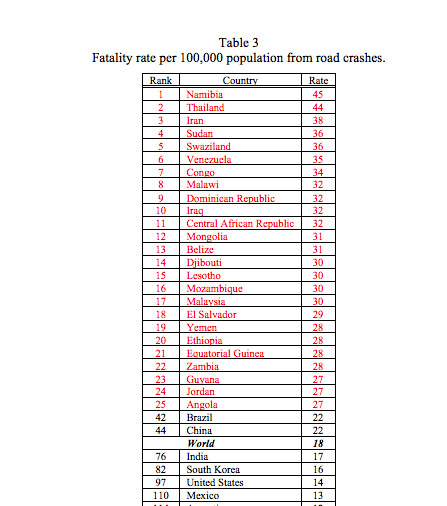14,059 reported road-deaths per year, 24,237 actual deaths says WHO, which is about 44 people per per 100,000 — the second highest rate in the world.
With 32,476,977 vehicles registered in Thailand, riders of motorcycles and three-wheelers are by far the largest group to be killed in road accidents (73%) followed by passengers of 4-wheeled cars (7%) and drivers of 4-wheeled cars (6%).
The only countries near Thailand’s huge traffic-death rate were Iran (38 per 100,000), Sudan (36) and nine African countries that between 30 and 35. Thailand was second only to Namibia, which had 45 road deaths per 100,000. Please take note that the world’s average is only 18 per 100,000.
Lack of Regulations
The lack of regulations is particularly noticeable in Thailand:
1. There is no child restraint law (e.g. safety seat or seat belt for children).
2. There are no safety audits for new road construction projects.
3. There are no regular inspections of road infrastructure.
4. Thailand has no policies to separate motorists from pedestrians and cyclists (e.g. to keep motorcycles off sidewalks used by pedestrians).
5. Thailand’s national seat-belt law does not apply to all passengers in a car.
Safer Roads through Tech
The internet of things (IoT) revolution is something that most people are still waiting for. We hear the term and think smart homes, where we can say “chill out” both to lower the temperature and change music genres on the sound system. Or we think shirts that tell us if our heart rate has gone up and also if we have unread emails.
But the reality is that IoT is already in a lot of different industries, changing them slowly but fundamentally. TSPs(Telematics Service Providers) are putting the technology to use in fleet management for logistics companies using telematics – technology used in devices for sending and receiving information remotely. In moving vehicles, this information can include navigation and monitoring.
Through TSP’s web platform, businesses can monitor their fleet in real-time and glean insights using built-in data analytics capabilities. Various types of sensors are installed on vehicles to capture data, and then back offices can do analysis of that data and try to identify patterns.
An analytics engine uses the data gathered by the sensor devices to provide insights into things like vehicle performance, driver behaviour, traffic information, etc. A mobile app allows the customers to keep track of their vehicles. By tracking a given fleet, the back office can then come up with conclusions and recommendations that help optimise how it is used. This helps reduce costs for the customers. It also helps alleviate traffic and promote environment-friendly driving.
There are quite a few companies offering fleet management in the ASEAN region, including Cartrack, Coolasia, and Mappoint Asia, etc. New comers may face some difficulties and challenges, however as long as they can find their unique approaches, such as focus on reporting and analytics, then it should be fine.


Your content is very good. Own insight. I like it a lot.
I am exploring for a answer related to road building for my clientele.
I will share your own article with our users. Intended for his reference.
good luck
Porn
Viagra
Viagra
Scam
Porn